美国国防部每日通讯
U. S. Department of Defense Daily News

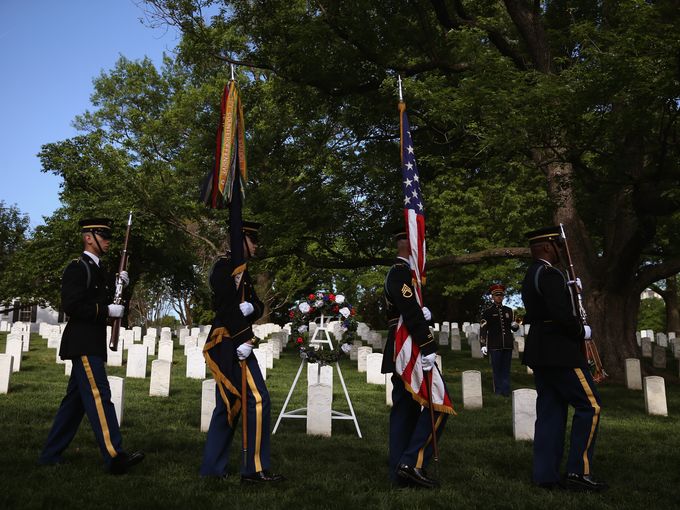
Arlington National Cemetery marks 150 years, 05/13/2014
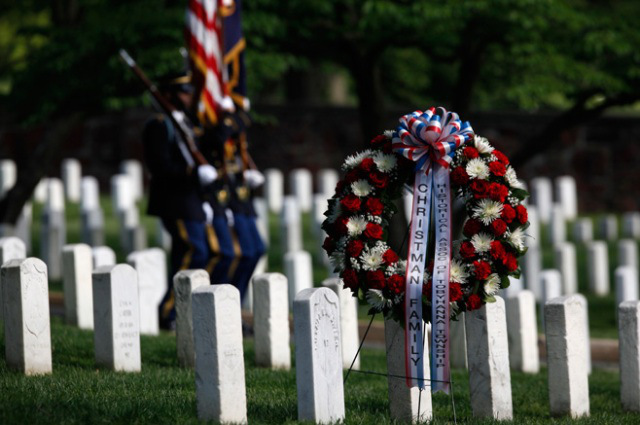
U.S. Army honor guard arrive before the wreath laying at the grave site of Army Pvt. William Christman, who was the first military burial at the cemetery, marking the beginning of commemorations of the 150th anniversary of Arlington National Cemetery in Arlington, Va., Tuesday, May 13, 2014. Christman, 20, enlisted in the 67th Pennsylvania Infantry and was hospitalized for measles five weeks later, dying on May 11, 1864 and buried at Arlington on May 13. (AP Photo)
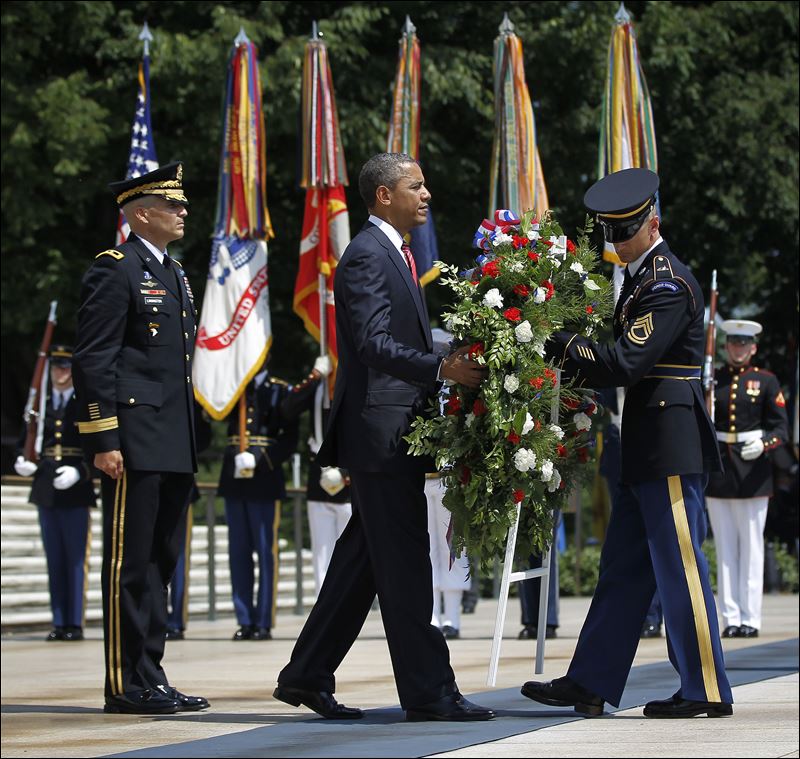
President Barack Obama, center, with Maj. Gen. Michael S. Linnington, left, Commander of the U.S. Army Military District of Washington, during a wreath-laying ceremony at the Tomb of the Unknowns at Arlington National Cemetery. ASSOCIATED PRESS
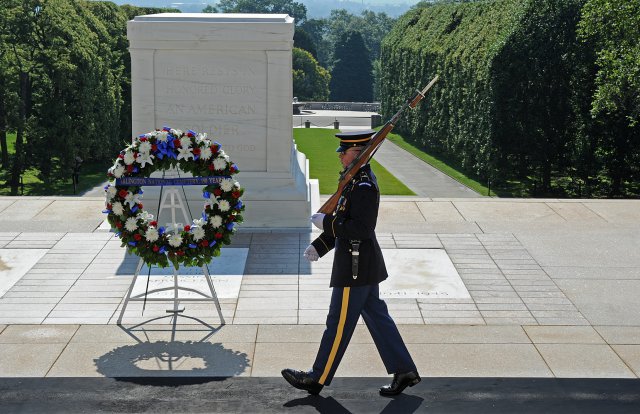
Arlington National Cemetery Plans Anniversary Commemoration
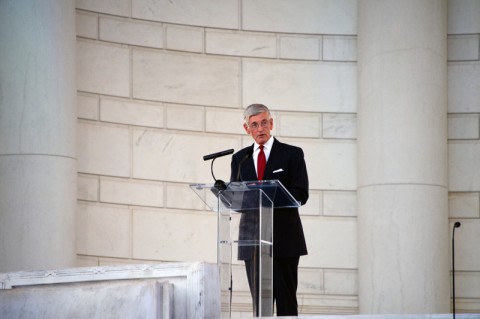
The Secretary of the Army John McHugh addresses the audience during the 150th anniversary of the establishment of Arlington National Cemetery in Arlington, Va., June 15, 2014. (Spc. Michael Mulderick/U.S. Army)
From an Arlington National Cemetery News Release
ARLINGTON, Va., June 13, 2014 - A special program will commemorate the 150th anniversary of Arlington National Cemetery on June 15.
"Arlington at 150" is an hour-long live military show featuring musical performances by "The President's Own" U.S. Marine Band and a joint chorus composed of singers from the Army, Marine Corps, Navy and Air Force are on tap, as well as a wreath ceremony and historical vignettes that showcase how military conflicts have shaped the nation and the cemetery.
The event is free and open to the public. The show will start at 8:30 p.m. EDT, with a pre-show at 8 p.m.in the Arlington National Cemetery Memorial Amphitheater. This is the first time Arlington has hosted an evening event in the amphitheater, officials said. Seating is available on a first-come, first-served basis. Officials said people to arrive early to ensure access and should plan to be seated by 8 p.m.
Free parking is available in the Welcome Center parking lot, and Defense Department ID card holders may park on Joint Base Myer-Henderson Hall and walk to the amphitheater. A free shuttle service will provide transportation from the Welcome Center to the Memorial Amphitheater. The last shuttle will leave the Welcome Center at 8:15 p.m., or when the Memorial Amphitheater is full.
Officials also encourage people to bring clear plastic refillable water bottles. Water stations will be available near the amphitheater to refill the water bottles.
The event will be carried live on the Pentagon Channel and will be streamed live on the channel's website.
|
Related Sites:
Arlington National Cemetery
Special Report: Arlington National Cemetery's 150th Anniversary
The Pentagon Channel
|
|
Commemorate the Anniversary of Arlington National Cemetery through Government Documents

This year marks the 150th anniversary of the designation of Arlington National Cemetery. On May 13, 1864, the body of Private William Henry Christman of Pennsylvania was laid to rest on the grounds of Arlington House, the former home of Gen. Robert E. Lee until the Civil War. Private Christman was the first soldier laid to rest at Arlington National Cemetery, one month prior to its official establishment as a military cemetery. The first of many events to be held this summer commemorating this important anniversary, began on May 13, 2014 with the laying of a wreath at Private Christman’s grave. Special Guided Tours are also planned, through the months of May and June. The events conclude with a laying of a wreath at the Tomb of the Unknown Soldier on June 16th.
 A wreath is placed at the grave of Army Private William Christman, the first person laid to rest at Arlington National Cemetery. Image source: http://www.dcmilitary.com There are many Government documents available to learn more about the Civil War, Arlington House, and the designation and history ofArlington National Cemetery. For a brief history, check out the U.S. Department of Veterans Affairs publication, Arlington National Cemetery. You can also check out this fact sheet about the history and development of all VA National Cemeteries.
Arlington House and the development of Arlington National Cemetery
The National Park Service (NPS) has published several publications regarding the remarkable history of Arlington House, including the following publications, which are currently available from the U.S. Government Bookstore:
Arlington House: A Guide to Arlington House, The Robert E. Lee Memorial, Virginia. Although small in size like most NPS handbooks, this publication provides a wealth of information on the history of Arlington House. The publication opens with an introduction of General Lee and Arlington House. It also presents a brief historical account of the house and its occupants, the Custises and the Lees, as well as providing concise information on the house and its grounds.
The National Park Service also published a Cultural Landscape Report about Arlington House in 2001. As stated in the report, “It’s hard to imagine today what the grounds of Arlington House originally looked like because of the graves of Arlington National Cemetery that surround the house. Arlington National Cemetery almost overwhelms Arlington House.” This Cultural Landscape Report and Site History about Arlington House, tells the story of the creation and use of Arlington House and its link to the formation and design of our national cemetery. It compiles in one place the site’s heritage, documents the changes over time, and establishes what is important to preserve. To learn more about Cultural Landscape Reports read A Guide to Cultural Landscape Reports: Contents, Process, and Techniquesavailable from the GPO Bookstore. You can also read “Custis-Lee Mansion: The Robert E. Lee Memorial” online from the National Park Service, or check out a print copy at a local Federal depository library.
National Cemetery Burial Eligibility
Arlington National Cemetery holds about 27 funerals each week. There are several House Committee Reports regarding veterans’ eligibility for burial in Arlington. H.R. 3211 of the 105th Congress, as well as H.R. 3423 from the 107th Congress amended Title 38 of the U.S. Code to modify eligibility of burial in Arlington National Cemetery. You can access hearings, as well as thelegislative history for H.R. 3423 and other bills online. You can also visit aFederal depository library for older reports concerning burials, such as a 1921 report before a subcommittee on the Expenses of burial in Arlington Cemetery of an unknown member of the Expeditionary Forces. You can also browse the volumes of “The war of the rebellion: a compilation of the official records of the Union and Confederate armies” for any records of the history of Arlington House and the appropriation of the land by the Federal government after the war. The volumes are available at many Federal depository libraries.
Arlington National Cemetery Memorials
There are many memorials at Arlington National Cemetery commemorating wars, notable military figures, presidents, and service men and women. If you visit a Federal depository library you could check out a copy of “In Remembrance of a Sailor: a shrine to America’s heroes”, a 1990 publication from the U.S. Navy Department. Information about other memorials in the cemetery can be found on the Arlington Cemetery website.
The Tomb of the Unknown Soldier
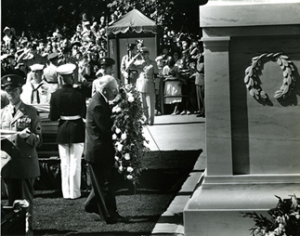
Left: President Dwight D. Eisenhower places a wreath at the Tomb of the Unknown Soldier of World War I during interment ceremonies for the Unknown Servicemen of World War II and the Korean Conflict, at Arlington National Cemetery. Image source: Old Guard
The Tomb of the Unknown Soldier was approved by Congress on March 4, 1921. Details of the act can be found in the Congressional Record from that period. You can visit a Federal depository libraryto access historic copies of the Congressional Record and view the enabling legislation for theTomb of the Unknowns. The remains of soldiers from World War I, World War II, and the Korean War lay in state and are honored by The Old Guard. In 1984, the remains of an unknown Vietnam War soldier were interred in the Tomb of the Unknown. A document about this soldier, “The Unknown Serviceman of the Vietnam War Era” was created by the U.S. Army Center of Military History. You can read more about it at a Federal depository library, or online from the HathiTrust. Pictures of the Tomb of the Unknowns can be found on the Old Guard Pinterest Board.
If you’re not in the Washington, DC area to participate in any of the events mentioned in this blog, curl up with these documents and immerse yourself in the history and stories of the men and women who fought for our country and were laid to rest on the grounds of the National Cemetery.
Arlington National Cemetery caps 150th year at Tomb of the Unknowns
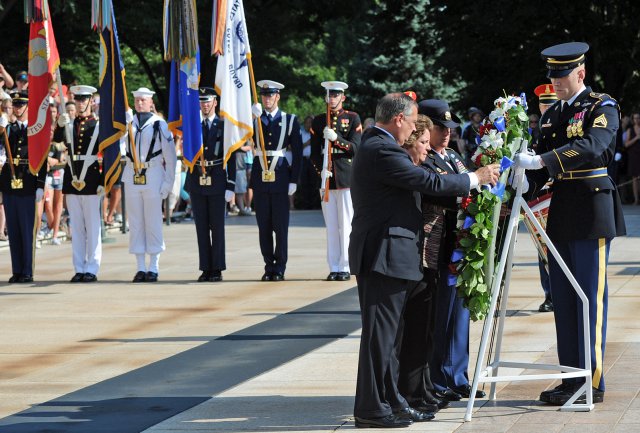
WASHINGTON (Army News Service, Jun 16, 2014) -- A little more than one month ago, on May 13, Arlington National Cemetery began to commemorate the 150th anniversary of its establishment with a wreath-laying ceremony at the grave of Pvt. William H. Christman, a Union Soldier who was the first to be interred on the 624-acre grounds.
Today, Arlington National Cemetery held its final event of the 150th commemoration, by holding a wreath-laying at the Tomb of the Unknowns. A crowd of visitors gathered around to witness the always-solemn ceremony.
"Arlington National Cemetery is a place where, for 150 years, our nation has been coming to remember the service, the sacrifice, and especially the ultimate sacrifice our members of the Armed Services have made," said Arlington National Cemetery Superintendent Jack E. Lechner Jr. "It's a place where Americans in common prove that we do remember, and that we will never forget."
"This is an amazing place," noted Sgt. Maj. Brenda Curfam, senior enlisted advisor for Army National Military Cemeteries. "The honor and respect that we show our fallen comrades here will continue for another 150 years and beyond. It's what we owe to our service men and women."
Throughout the last month, Arlington National Cemetery has held lectures on its history, and special guided tours of its monuments and memorials taking visitors through its first 150 years by paying tribute to the thousands of active-duty service members and veterans from The American Revolution thru the conflicts of the 21st century.
Also during the commemoration, Arlington National Cemetery's Old Amphitheater was renamed, during a May 30 ceremony. The amphitheater was renamed in honor of Union Cpl. James R. Tanner, who lost both legs at the Second Battle of Bull Run, in August 1862. Tanner spent the remainder of his life advocating for veterans and lobbying for the establishment of the American Red Cross, which occurred in 1904.
"It's just a special place and a national treasure," said Retired Lt. Col. Renea C. Yates, who serves as Arlington National Cemetery deputy superintendent for administration. "The executive director reminds us that every headstone [marks] a hero to someone; every headstone has a story and I know for my children and I, this place will always be special.
"It was special before my husband passed, and it's special for me to know I will be laid to rest here," she said. "I wish [Arlington National Cemetery] all the best as we move forward into the next 150 years."
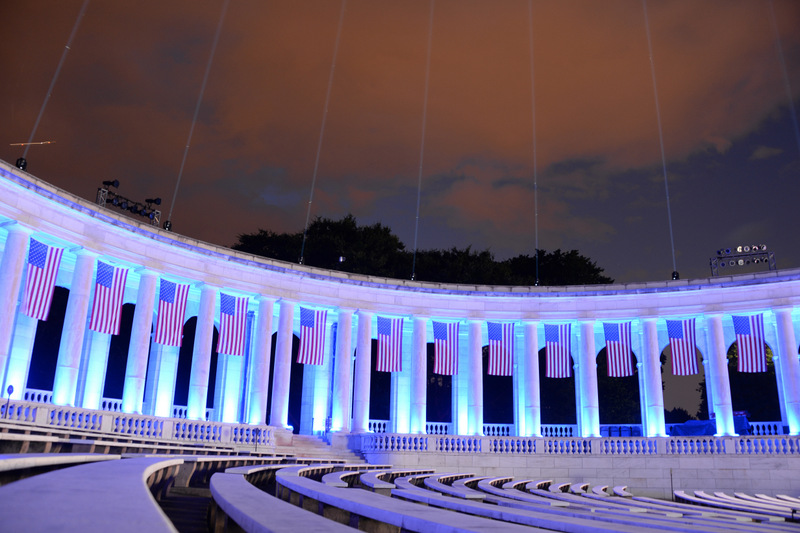
Equipment and lights are set up at the Memorial Amphitheater for the 150th anniversary of the establishment of Arlington National Cemetery in Arlington, Va., June 13, 2014. (Spc. Michael Mulderick/U.S. Army)
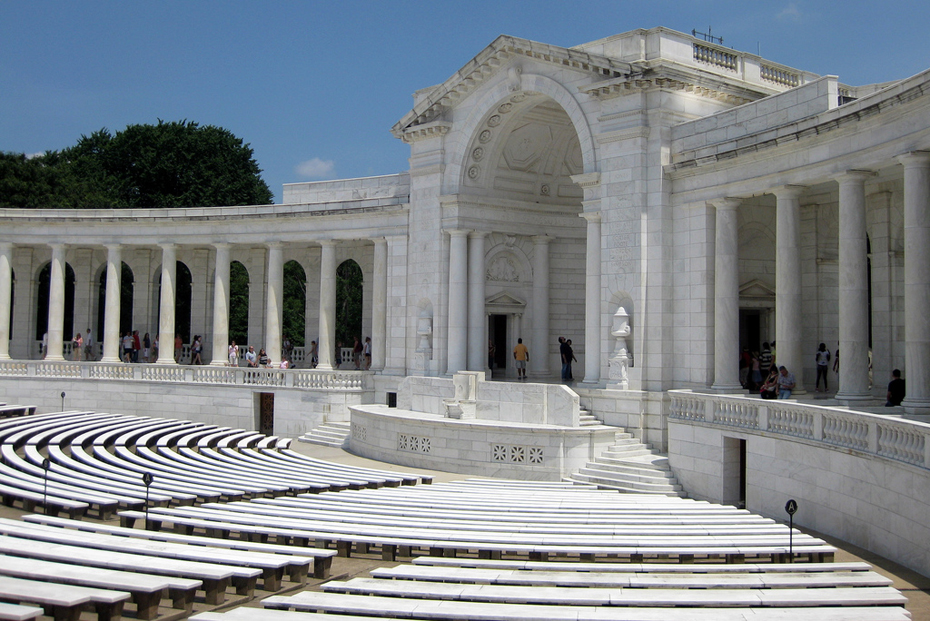 The Memorial Amphitheater at Arlington National Cemetery in Arlington, VA, was dedicated on May 15, 1920. While many ceremonies are conducted throughout the country, many consider the services at Arlington's Memorial Amphitheater to be the nation's official ceremonies to honor all American service members who serve to keep the United States free.About 5,000 visitors attend each of the three major annual memorial services in the Amphitheater. They take place Easter, Memorial Day and Veterans Day and are sponsored by the U.S. Army Military District of Washington. The Easter Sunrise Service begins at 6 a.m. Memorial Day and Veterans Day services always begin at 11 a.m. Many military organizations also conduct annual memorial services in the amphitheater.The Memorial Amphitheater was the dream of Judge Ivory G. Kimball, who wished to have a place to assemble and honor the American defenders.Because of Kimball's campaign, Congress authorized its construction March 4, 1913. Judge Kimball participated in the ground-breaking ceremony March 1, 1915, but did not live to see his dream completed. Ivory Kimball died May 15, 1916, and was buried in Section 3 of the cemetery, near the Memorial Amphitheater he campaigned to build. President Woodrow Wilson placed its cornerstone Oct. 13, 1915. The Memorial Amphitheater at Arlington National Cemetery in Arlington, VA, was dedicated on May 15, 1920. While many ceremonies are conducted throughout the country, many consider the services at Arlington's Memorial Amphitheater to be the nation's official ceremonies to honor all American service members who serve to keep the United States free.About 5,000 visitors attend each of the three major annual memorial services in the Amphitheater. They take place Easter, Memorial Day and Veterans Day and are sponsored by the U.S. Army Military District of Washington. The Easter Sunrise Service begins at 6 a.m. Memorial Day and Veterans Day services always begin at 11 a.m. Many military organizations also conduct annual memorial services in the amphitheater.The Memorial Amphitheater was the dream of Judge Ivory G. Kimball, who wished to have a place to assemble and honor the American defenders.Because of Kimball's campaign, Congress authorized its construction March 4, 1913. Judge Kimball participated in the ground-breaking ceremony March 1, 1915, but did not live to see his dream completed. Ivory Kimball died May 15, 1916, and was buried in Section 3 of the cemetery, near the Memorial Amphitheater he campaigned to build. President Woodrow Wilson placed its cornerstone Oct. 13, 1915.

Representatives from the Irish Defense Forces, the Special Olympics and the Peace Corps pass a torch lit by the eternal flame in Arlington National Cemetery yesterday. The flame will travel to Ireland in order to commemorate the 50th anniversary of President Kennedy’s visit there.
(One hundred fifty-five years ago, a barrelmaker named Patrick Kennedy boarded a ship on the quay at New Ross, Ireland, bound for America, where his great-grandson would become the most famous Irish-American in history.Yesterday at Arlington National Cemetery, an Irish soldier in a dress-green uniform lit a torch from the eternal flame at the John F. Kennedy grave site. That torch will travel by plane, with special security permission, to Dublin, then by Irish navy ship to the New Ross quay, where it will light an eternal flame on a new monument to Irish emigrants.President Kennedy’s visit 50 years ago this month to New Ross, where he was greeted by rapturous crowds, closed the circle on his great-grandfather’s immigrant journey to America. And Saturday’s torch-lighting will close another, bringing JFK’s flame to a nation that considers him as much Irish as American.“This is the story of a young man returning home,” U.S. Rep. Joe Kennedy, a Massachusetts Democrat and the grandson of JFK’s brother, Robert F. Kennedy, said at the Arlington ceremony. Under a sky that was Irish gray but Washington hot, he added: “It is a story of a thousand welcomes and a million tears, the story every immigrant holds in his heart.”)

|




 A wreath is placed at the grave of Army Private William Christman, the first person laid to rest at Arlington National Cemetery. Image source:http://www.dcmilitary.com
A wreath is placed at the grave of Army Private William Christman, the first person laid to rest at Arlington National Cemetery. Image source:http://www.dcmilitary.com 
